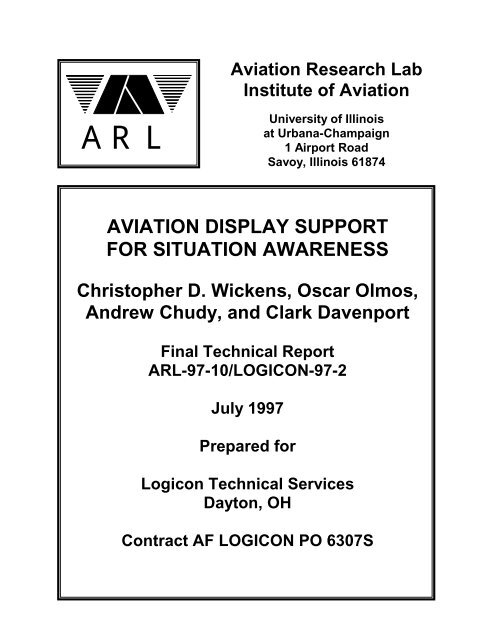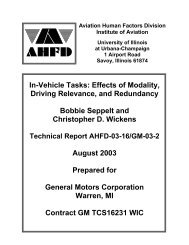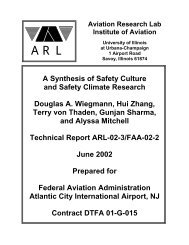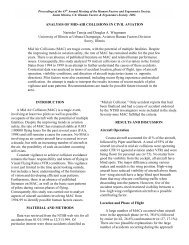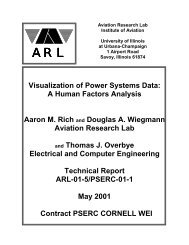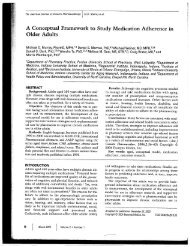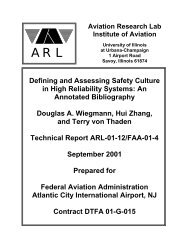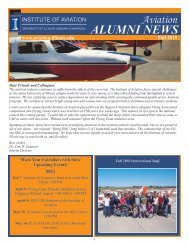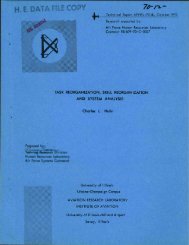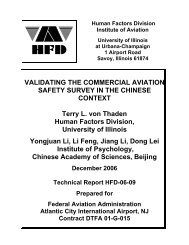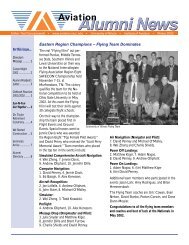Running head: TACTICAL DISPLAYS FOR COMBAT AWARENESS
Running head: TACTICAL DISPLAYS FOR COMBAT AWARENESS
Running head: TACTICAL DISPLAYS FOR COMBAT AWARENESS
You also want an ePaper? Increase the reach of your titles
YUMPU automatically turns print PDFs into web optimized ePapers that Google loves.
Aviation Research Lab<br />
Institute of Aviation<br />
ARL<br />
University of Illinois<br />
at Urbana-Champaign<br />
1 Airport Road<br />
Savoy, Illinois 61874<br />
AVIATION DISPLAY SUPPORT<br />
<strong>FOR</strong> SITUATION <strong>AWARENESS</strong><br />
Christopher D. Wickens, Oscar Olmos,<br />
Andrew Chudy, and Clark Davenport<br />
Final Technical Report<br />
ARL-97-10/LOGICON-97-2<br />
July 1997<br />
Prepared for<br />
Logicon Technical Services<br />
Dayton, OH<br />
Contract AF LOGICON PO 6307S
Abstract<br />
In this report, three prototype displays that are contrasted for aircraft navigation and tactical<br />
hazard awareness: a conventional 2D coplanar display, an exocentric (“God's eye”) 3D display, and<br />
an immersed (“pilot's eye”) 3D display. Strengths and weaknesses of each display type are<br />
discussed. In implementing these for Experiment 1, the immersed display was coupled with a<br />
global exocentric view of the airspace. In Experiment 1, thirty pilots flew with each of the displays<br />
around an airspace populated by waypoints, hazards and traffic. Performance measures revealed the<br />
anticipated costs and benefits of each display type. In Experiment 2, cognitive engineering<br />
principles were applied to remediate the weaknesses of each display type. Analysis of performance<br />
of 27 additional participants in flight path tracking and hazard awareness measures revealed success<br />
in application of the cognitive engineering principles. We also briefly describe the procedures<br />
employed in a third experiment in which additional design changes were examined.<br />
1
Introduction<br />
Rapid advances in computer graphics technology have made feasible a variety of possible<br />
formats of dynamic three-dimensional graphics for aviation displays. Options may include<br />
panoramic displays (Busquets, Parrish, & Williams, 1992), “highway in the sky” displays (Reising,<br />
Barthelemy, & Hartsock, 1989; Haskell & Wickens, 1993; Barfield, Rosenberg, & Furness, 1995;<br />
Flohr & Huisman, 1997; Theunissen, 1995), “virtual cockpits” (Haas, 1992) or somewhat more<br />
conventional 3D electronic maps (Wickens, Liang, Prevett, & Olmos, 1996; Olmos, Liang, &<br />
Wickens, 1997; Wickens & Prevett, 1995). On the one hand, the concept of three-dimensional<br />
displays makes intuitive sense, because the pilot's world is a very three-dimensional one. Yet<br />
empirically, whether the benefits of 3D displays outweigh their costs turns out to be a complex<br />
issue, depending upon the particular 3D rendering chosen, the nature of the task, and the structure<br />
of the information to be displayed. We consider these issues in turn.<br />
Display viewpoints. We first note that there are two qualitatively different viewpoints<br />
offered by 3D displays, shown to the left of Figure 1. The “immersed” or fully egocentric viewpoint<br />
(panel A) presents the world much as a pilot's eyes might see it from the cockpit (Theunissen, 1995;<br />
Flohr & Huisman, 1997; Jensen, 1981). The exocentric viewpoint (panel B) presents a view from<br />
behind and above ownship. In many respects, these two 3D viewpoints are as different from each<br />
other, as both are from the more conventional 2D display (panel C), with which they are often<br />
compared. However, we note that any fair comparison of 3D with 2D viewpoints must provide the<br />
latter with two orthogonal views of the airspace so that all viewpoints are provided with a spatial<br />
analog representation of the vertical axis (Fadden , Braune, & Wiedemann, 1991). Hence, we refer<br />
to this as the coplanar view.<br />
Tasks. One may distinguish at least four categories of spatially relevant aviation tasks which<br />
the above viewpoints must serve. Local guidance or navigation simply requires adherence to a<br />
flightpath leading forward from the nose of the aircraft. Navigational checking in visual<br />
meteorological conditions requires cross referencing map information with visual information in<br />
the forward view, to ascertain congruence between the two (Hickox & Wickens, 1996), and thereby<br />
establishing that the pilot is geographically oriented. Spatial or hazard awareness, a subset of the<br />
more generic concept of situation awareness, requires knowledge of the location, orientation and<br />
trend of entities (weather, other traffic, no-fly zones, terrain), lying within a much broader sphere of<br />
the surrounding airspace. Hazard awareness can be broken down in terms of the degree of precision<br />
with which location and trend must be determined. For example, a traffic display for collision<br />
avoidance must yield very precise location and trend information. In contrast, a combat display for<br />
general strategic planning, or a weather display for route planning imposes less precise<br />
requirements.<br />
2
( a ) ( b ) ( c )<br />
Distortion<br />
3D 2D<br />
Ambiguity<br />
Scanning<br />
Mental<br />
Integration<br />
Figure 1. Three canonical viewpoints for aviation displays and the resulting display depiction: (a)<br />
egocentric or immersed; (b) exocentric or “tethered”; (c) coplanar. (a) and (b) are considered “3D”<br />
displays; (c) is a 2D display under which each display is listed the associated human<br />
perceptual/cognitive costs.<br />
Information. The information itself, upon which the above tasks are dependent, may vary in<br />
its distribution across a 3D volume in ways that appear to influence the effectiveness of different<br />
display viewpoints. Such information may lie along constrained 2D planes (e.g., such as a flat<br />
segment of terrain, or the flight path of a level aircraft) or may be distributed as less constrained 3D<br />
volumes or trajectories (e.g., the 3D volume of hazardous weather region, or the 3D flight path of<br />
an attacking hostile aircraft). In the former case, the dimensional constraints may be assumed by the<br />
user perceiving the display, imposing some level of top-down perceptual processing. In the latter<br />
case, these constraints cannot be imposed.<br />
Empirical data. Different display viewpoints appear to be differentially effective for the<br />
different tasks discussed above. The most robust finding regarding the costs and benefits of the<br />
three prototype display viewpoints shown in Figure 1 is that the immersed “tunnel in the sky”<br />
display is superior to the other two prototypes for guidance tasks (Barfield et al., 1995; Haskell &<br />
Wickens, 1993; Wickens & Prevett, 1995; McCormick & Wickens, 1995), and for navigational<br />
checking (Hickox & Wickens, 1996). The advantage for guidance appears to result both from the<br />
compatibility or congruence between the location of the display viewpoint and the axis of control<br />
rotation, and because of the higher gain by which rotational motion is represented on the display.<br />
However, the same immersed viewpoint appears to be inferior as a means of providing hazard<br />
awareness information. This inferiority results either because the display provides only a “keyhole”<br />
3
view of the world behind and around ownship (Woods, 1984), or because an expanded geometric<br />
field of view (designed to address the keyhole phenomenon) severely distorts the perceived position<br />
of hazards (Wickens & Prevett, 1995).<br />
In contrast to the clearly demarked findings for the immersed display, the differences<br />
between coplanar and exocentric formats are more subtle, as they depend upon a tradeoff between<br />
two information processing mechanisms. On the one hand, the coplanar format imposes on the pilot<br />
a visual scanning requirement in order to fixate the two views, and an added cognitive load required<br />
to mentally integrate them. On the other hand, the exocentric format suffers from the ambiguity<br />
with which the 3D location of entities is collapsed onto the 2D viewing surface (Gregory, 1973;<br />
McGreevy, & Ellis, 1986). Location of either ownship or hazards is imprecisely determined along<br />
the line of sight, and the perceived orientation and length of the vector connecting the two (i.e., the<br />
azimuth, elevation angle, and distance from ownship to a hazard) will be degraded by the imprecise<br />
estimates of both endpoints of the vector (McGreevy & Ellis, 1986).<br />
Our research findings have indicated that the contributions of either scanning or ambiguity<br />
to the costs and benefits of coplanar versus exocentric displays will be modulated by a number of<br />
other factors. For example, to the extent that the combined implications of change on all three<br />
dimensions is relevant, the scanning costs of the coplanar display appear to impose a greater penalty<br />
(Wickens, Merwin, & Lin, 1994; McCormick & Wickens, 1995). But to the extent that there is a<br />
need for precise estimation of 3D position (e.g., estimating the position and trajectory of air traffic),<br />
then the 3D ambiguity costs begin to dominate, as revealed by our findings in air traffic control<br />
(May, Campbell, & Wickens, 1996; Wickens, Miller, & Tham, 1996), and cockpit traffic displays<br />
(Merwin, O’Brien, & Wickens, 1997). However, even this 3D ambiguity cost for precise location<br />
estimation appears to be mitigated by the extent to which the viewer assumes that properties within<br />
the environment constrain the ambiguity of positions (e.g., knowledge that all points lie along a<br />
level surface or flight path). This explains why 3D ambiguity problems in trajectory estimation are<br />
not observed with level traffic in either air traffic control displays (Wickens, Miller, & Tham, 1996)<br />
or cockpit traffic displays (Merwin et al., 1997).<br />
Finally, in circumstances in which there is not a requirement for high precision of spatial<br />
estimates, and in which some constraints on 3D spatial behavior are present (e.g., the continuous<br />
and predictable descent of an aircraft on approach to landing), it is not surprising that our results<br />
have revealed rough equivalence between the two display types (Wickens, Liang, Prevett, & Olmos,<br />
1996; Wickens & Prevett, 1995), and have sometimes revealed a trend in favor of the 3D display,<br />
with its reduced scanning requirements (Olmos et al., 1997).<br />
Many of the empirical comparisons between 2D and 3D displays, to support both guidance<br />
and hazard awareness, have been carried out in the context of civil aviation, in which maneuvering<br />
performance is relatively constrained by “rules of the airspace.” However, in many aspects of<br />
combat tactical maneuvering, such constraints are entirely absent, suggesting two competing<br />
alternatives. On the one hand, it is possible that a high degree of 3-dimensional maneuvering might<br />
impose a greater cost of scanning and cognitive integration with the coplanar display, rendering it<br />
inferior. Such an interpretation can be offered to explain the superiority of 3D over coplanar<br />
displays in data visualization experiments carried out by Wickens et al. (1994) and by McCormick<br />
and Wickens (1995). On the other hand, it may be that when the constraints on information location<br />
4
and trajectories are removed, this will amplify the ambiguity costs associated with 3D (perceptive)<br />
displays in hazard location awareness.<br />
In order to investigate these issues, two experiments are reported here that evaluated the<br />
relative merits of the three display prototypes in supporting 3D flight path tracking, and tactical<br />
hazard awareness regarding the 3D volume of airspace around a simulated combat aircraft. In<br />
Experiment 1, we compare performance of the three “baseline” displays. However, we make one<br />
important and necessary modification to the egocentric viewpoint (Figure 1a). Since the keyhole<br />
effect associated with this viewpoint is unacceptable for hazard awareness in air-to-air combat<br />
(hostile targets in the rear quarter often represent the greatest hazards), the immersed forward view<br />
(a “local display”) was coupled with a large scale (but small resolution) global display positioned in<br />
the lower portion of the viewing area. Hence, we refer to this as the “split screen” display. Thus, all<br />
three displays depict the same region of airspace on the same display screen size, but from different<br />
viewpoints (or combinations of viewpoints). In Experiment 1, participants flew to a set of<br />
waypoints positioned among a series of hazards, and were required periodically to orient to air<br />
targets. We anticipate the experimental data to reflect the strengths and weaknesses of each display<br />
type for the set of tasks employed, as discussed above. Then in Experiment 2, we attempt to apply<br />
cognitive engineering principles, to address the inherent weaknesses of each display type, without<br />
simultaneously encumbering them with alternative shortcomings.<br />
Experiment 1: Baseline Comparison<br />
Participants. Thirty University of Illinois Institute of Aviation personnel, all licensed<br />
pilots, participated in the experiment, each receiving payment of $5.00 per hour. Flight<br />
experience varied from 65 to 2000 hours with a median time of 250 hours. Participants ranged<br />
from 18 to 45 years of age. All participants flew with all three display formats. However, before<br />
flying with each unique display condition, participants were given a short practice session to<br />
familiarize themselves with the display format. All participants received the same instructions<br />
and performance measures.<br />
Apparatus and Flight Dynamics<br />
The study was conducted on a Silicon Graphics IRIS workstation with a 16-inch diagonal<br />
screen. Navigation was controlled with a two-degree-of-freedom joystick which was attached to<br />
the right arm of the participant's chair. Standard aviation dynamics were employed so that<br />
pushing forward on the joystick caused the aircraft to pitch down with a subsequent loss of<br />
altitude, while pulling back on the joystick caused the aircraft to pitch up, thereby increasing<br />
aircraft altitude. The degree of pitching up or down directly controlled the rate of altitude change.<br />
Moving the joystick to the right or left made the aircraft roll right or left, respectively. Roll angle<br />
was directly proportional to the rate of <strong>head</strong>ing change and the aircraft was not allowed to roll<br />
past 90 degrees in either direction. Pitch and roll were directly coupled such that for a given roll<br />
rate the aircraft would have a proportional tendency to pitch down. Power was held constant,<br />
although airspeed was allowed to vary from 180 knots at level flight to a minimum of 160 knots<br />
in a climb and a maximum of 190 knots in a descent. There were no throttle or rudder controls.<br />
5
Display<br />
The world in which the pilots flew, with respect to the location of both terrain and hazard<br />
volumes, was the same across all display conditions. Terrain was represented with transparent<br />
geometric wire frame objects and hazard volumes were depicted by inverted radar coverage<br />
cones (Figures 2, 3, & 5). To reduce any carryover effects across display conditions, each session<br />
with a new display began with the aircraft in a different location and at a different altitude. In<br />
addition to changing aircraft location, the location of the various waypoints was also altered for<br />
each unique display condition. A rotating map was employed for all three display formats.<br />
2D coplanar display (Figure 2): For the 2D display, both a planar and a profile view were<br />
provided to present lateral and vertical information, respectively. The planar (horizontal<br />
situation) view was placed at the top of the display and presented information from a bird’s eye<br />
perspective; hence, no vertical information was provided in this viewpoint. To ensure depiction<br />
of threats in front of and behind ownship the participant’s aircraft was placed at the center of the<br />
display. The profile view was placed at the bottom of the display and presented vertical<br />
information from a viewpoint orthogonal to the aircraft's moment-to-moment location, with a 0°<br />
azimuth angle (parallel to the fuselage), and at an elevation angle of 0°. As with the plan view,<br />
the pilot’s aircraft was placed at the center of the profile view to ensure adequate threat depiction.<br />
To aid vertical control, a predictor in the form of two poles, one at the front and one at the rear of<br />
the aircraft and extending to a grid surface below the aircraft was added to the aircraft icon.<br />
3D exocentric display (Figure 3): The perspective display combined lateral and vertical<br />
information into a single display by employing a “tethered” exocentric viewpoint (Wickens &<br />
Prevett, 1995). The display viewpoint was placed at a distance of 40,000 display feet from the<br />
aircraft. A vertical predictor similar to that used in the 2D condition was used to help provide<br />
altitude information. In order to ensure that the predictor did not lie along the line of sight of<br />
projection and hence become invisible, an azimuth offset of 15° was used. A geometric field of<br />
view of 50° was employed to help with the depiction of threats beside and behind ownship. An<br />
elevation angle of 30° was also used to assist the participants with vertical judgments. These<br />
projection parameters for the exocentric viewpoint are schematically depicted in Figure 4.<br />
3D split-screen display (Figure 5): The split-screen display combined two differing<br />
perspective viewpoints, both of which employed a 50° GFOV. The first viewpoint, placed at the<br />
top of the display panel, was a fully egocentric “immersed” perspective similar to what would be<br />
seen by a pilot looking out of the windscreen (Wickens & Prevett, 1995). The second viewpoint,<br />
placed at the bottom of the display screen, was presented from an exocentric perspective similar<br />
to that of the 3D display described above. However, in order to provide a more global view of the<br />
world, the viewpoint distance with the exocentric display was increased from a value of 40,000<br />
feet to 45,000 feet and the elevation angle was increased from 30° to 45°. Also, because<br />
participants would presumably use the egocentric viewpoint for primary flight control, the<br />
azimuth offset in this display was decreased from fifteen to zero°.<br />
6
Figure 2. 2D coplanar display.<br />
7
Figure 3. 3D exocentric display. The next waypoint is shown by the cube mounted on the pole<br />
a<strong>head</strong> of the aircraft.<br />
8
40,000 feet<br />
30 Deg. Elevation Angle<br />
50 Deg. FOV<br />
Display<br />
Generator<br />
15 Deg. Azimuth Offset<br />
Current Heading<br />
Figure 4. Projection parameters of the exocentric viewpoint.<br />
9
Figure 5. 3D split screen display. The upper panel is the immersed egocentric view.<br />
10
To aid the participants in their navigation task there were three additional augmentations<br />
to the standard displays described above: 1) An Attitude Directional Indicator (ADI) was placed<br />
at the top of the each display to aid inner-loop flight control. 2) A digital readout of the aircraft's<br />
current airspeed was also placed to the left of the ADI. 3) To help participants quickly orient to<br />
the next waypoint, a series of concentric rings (set at one mile apart) and lines emanating from<br />
the aircraft was created which formed a “dart board” that surrounded the aircraft.<br />
Task<br />
For each display condition, all participants were asked to navigate as quickly and directly<br />
as possible to a specific waypoint which was depicted in the environment by a flashing yellow<br />
cube. To aid altitude encoding, a reference line, extending from the bottom of the cube to the grid<br />
below, was added to each waypoint (Ellis, McGreevy, & Hitchcock, 1987). For each navigation<br />
leg only one waypoint appeared in 3D space. As a result, once the participant successfully<br />
intercepted the specified waypoint it vanished and a second waypoint appeared. Participants were<br />
asked to navigate to a total of eight waypoints for each display format. All waypoints were<br />
separated by a distance of 24,000 feet and all were positioned randomly in both location and<br />
altitude. Once the 8th waypoint was intercepted the session would terminate. Hence, the only<br />
break that occurred was between display conditions.<br />
These eight legs within each flight were composed of the following:<br />
1) Two straight legs. For these legs no excessive lateral or vertical maneuvers were<br />
required to reach the next waypoint. For example, for a given straight leg participants needed<br />
only to descend or climb to reach the next waypoint. That is, no hazard volumes or terrain were<br />
present in the participant’s path.<br />
2) Six maneuvering legs due to permanent hazards. In order to reach the next waypoint as<br />
quickly as possible participants needed to circumnavigate permanent hazards which were present<br />
in their path. This would necessitate a decision on the participant’s part as to whether a climb,<br />
descent, turn, or combination climbing turn/descending turn would result in the shortest<br />
navigation time to the next waypoint. Of the six maneuvering legs, two could be navigated most<br />
rapidly with a lateral maneuver, two with a vertical maneuver, and two required a combination of<br />
lateral and vertical maneuvers.<br />
In addition, within the six maneuvering legs there were two legs in which an external<br />
threat appeared at some random position that was in the view for all three displays, and two<br />
within which a hazard volume appeared in the participant’s path. The appearance of a hazard<br />
volume required some added maneuvering in addition to that which was required due to the<br />
presence of a permanent hazard.<br />
Performance Measures<br />
1) Total time for each leg: The timing for the individual legs began when the next<br />
waypoint began flashing and ended when the participants intercepted the specified waypoint.<br />
Participants were encouraged to fly the shortest route possible to each waypoint. Hence, since<br />
11
airspeed was constant, excessive time measures would indicate a deficiency in local guidance, as<br />
well as difficulties in efficiently circumnavigating the hazards.<br />
2) Contact with surrounding terrain/hazards: The total number of contacts was<br />
measured within each leg and the total time within the terrain/hazard volume was also measured<br />
for each leg. If contact did occur participants were immediately alerted with a beeping tone. For<br />
each particular display condition, this measure was designed to assess participants’ awareness of<br />
surrounding hazards.<br />
3) External threat identification: At unexpected times during the navigation task, an<br />
external threat appeared on the participant’s display in the form of a red aircraft icon. Participants<br />
were asked to verbally identify the location of the external threat as quickly as possible according<br />
to the following format:<br />
A) O’clock position: 1 to 12.<br />
B) Altitude:<br />
HIGH: meaning the threat is higher than current altitude.<br />
LEVEL: the threat is at current altitude.<br />
LOW: the threat is below current altitude.<br />
C) Trend:<br />
CLOSING: the threat is approaching.<br />
OPENING: the threat is receding.<br />
The experimenter encoded the verbal responses onto the computer. Both the latency of the first<br />
word of the vocal utterance and the accuracy of response was measured for each individual<br />
response. Accuracy of response was collected by comparing the participant’s actual response to<br />
the ideal response. The ideal response was based on the pilot’s XYZ position and trend at the<br />
moment the threat appeared.<br />
4) Pop-up conflicts: As with the external threats, at unexpected times during the<br />
navigation task, a hazard volume would appear in the participant’s path. The participant’s task<br />
was to decide on a maneuver that would circumnavigate the hazard as quickly as possible. When<br />
an appropriate maneuver was decided upon, participants keyed a button on the joystick and<br />
immediately commenced the maneuver. A time measure was recorded in seconds for both length<br />
of decision time and length of maneuvering time around the hazard. Both measures began at the<br />
moment the hazard volume appeared. There were two pop-up conflicts that appeared for each<br />
display format. In order to circumnavigate the pop-up hazard as quickly as possible, one required<br />
a lateral maneuver while the other required a vertical maneuver.<br />
5) Flight path position: The participant’s XYZ position was recorded every five seconds.<br />
This was done in order to later determine the quality of maneuvers (i.e., climb, turn) that were<br />
used to navigate around the hazards presented.<br />
12
Design and Procedure<br />
A repeated measures design was used so all 30 participants were randomly broken into<br />
six groups, each of which were randomly assigned to one of six display condition orders. These<br />
were defined by cycling twice through the three display conditions, each time in a different order.<br />
Upon arrival, participants were given instructions explaining the purpose of the experiment and<br />
the tasks they would encounter. After reading the instructions, participants were seated in a dimly<br />
lit room in front of the IRIS workstation.<br />
Three practice sessions and three experimental sessions were conducted in a one-day<br />
experiment. During each of the practice sessions participants were encouraged to fly the shortest<br />
route possible to each waypoint. The experimenter ensured that participants understood the<br />
different features shown with each particular display format. After completing the practice<br />
session the experimenter left the room and the experimental session began. During each of the<br />
experimental sessions, participants experienced two external threat identification tasks and two<br />
pop-up conflict tasks. The location of the external threats and hazard volumes was altered for<br />
each experimental session with a new display format.<br />
Results: Experiment 1<br />
The data for the baseline experiment are shown in Figures 6-8 in the white bar graphs. (The<br />
dark bar graphs represent the data for Experiment 2, and will be described subsequently.) Shown in<br />
Figure 6 is the mean time to traverse all waypoints within a mission as a function of display type.<br />
The significant effect of display (F(2,40) = 20.7, p < 0.01) revealed the clear (and predicted)<br />
advantage of the immersed, split screen display for this local guidance task, relative to the costs<br />
shown by the coplanar format (reflecting the lateral and vertical cross panel integration of costs),<br />
and the costs shown by the 3D exocentric format (reflecting ambiguity in estimating ownship<br />
position and <strong>head</strong>ing). Subsequent analysis revealed that the major deficiency of the exocentric<br />
format was in the fine maneuvering required to capture the 3D spatial envelope surrounding each<br />
waypoint (see also Andre, Wickens, Moorman, & Boschelli, 1991).<br />
Further analyses revealed differential costs for the coplanar and exocentric displays on<br />
vertical (climbing or descending) versus lateral (turning) legs. Performance with the coplanar<br />
display suffered the greatest costs on legs involving only vertical maneuvers (F(1,20) = 10.35; p <<br />
0.01) while the exocentric display showed the greatest costs on lateral maneuvering legs whether<br />
these were level (F(1,20) = 31.9, p < 0.01) or also involved vertical maneuvering ) F = 13.93, p <<br />
0.01).<br />
Figure 7 presents the amount of time spent within a hazard volume (e.g., ownship has<br />
temporarily penetrated a radar coverage zone). While these times are relatively short (around 1<br />
second in a several minute flight. They are still non-zero. Again they reflect the marginally<br />
significant advantage of the split screen display, and its ego-referenced guidance panel in<br />
supporting this aspect of navigation (F= 2.93; p < 0.01). This cost was greatest for the coplanar<br />
display, and on those legs requiring lateral maneuvers.<br />
13
Time<br />
(sec)<br />
116<br />
114<br />
112<br />
110<br />
108<br />
106<br />
104<br />
102<br />
Experiment 1<br />
Experiment 2<br />
Coplanar Exocentric Split-Screen<br />
Means of Leg times vs Display Type<br />
Figure 6. Mean travel time/leg. White bar graphs represent data from Experiment 1. Black bar<br />
graphs are data from Experiment 2.<br />
1.6<br />
1.4<br />
Contact Time (sec)<br />
1.2<br />
1<br />
0.8<br />
0.6<br />
0.4<br />
Experiment 1<br />
Experiment 2<br />
0.2<br />
0<br />
Coplanar Exocentric Split-Screen<br />
Mean Contact Time per Leg vs Display<br />
Figure 7. Mean time contacting hazard volumes per leg.<br />
14
Response Time (sec)<br />
16<br />
14<br />
12<br />
10<br />
8<br />
6<br />
4<br />
2<br />
0<br />
Experiment 1<br />
Experiment 2<br />
Coplanar Exocentric Split-Screen<br />
Mean Response Time to Pop-Up Threat vs Display<br />
Figure 8. Mean response time to aircraft threat.<br />
Figure 8 presents the time required for pilots to respond to a traffic threat, as inferred by the<br />
time to initiate the first component of their identification response. In this case the significant effect<br />
(F= 19.85; p < 0.01) reverses the pattern shown in the guidance measures plotted in Figures 6 and 7,<br />
and indicates a substantial cost imposed by the split screen display. A subsequent debriefing of the<br />
participants revealed that the cost was attributable to the “compelling” nature of the immersed<br />
screen (on top), which appeared to inhibit participants from allocating much of their visual attention<br />
to monitoring the global hazard awareness screen below. Note in contrast that on the coplanar<br />
display, information necessary for the primary guidance task was distributed across both panels, and<br />
on the exocentric display there was only one, unified panel. A comparison between the coplanar<br />
and exocentric format revealed the latter, with its single integrated panel, to have a marginally<br />
significant benefit for response time (F(1,19) = 3.66, p < 0.08).<br />
Our assessments of the accuracy of estimating azimuth and closure of the intruder traffic<br />
revealed no differences between the three display formats. However, Figure 9 suggests a marked<br />
influence on the estimation of intruder altitude (F= 7.54; p < 0.01). The coplanar display, with its<br />
linear depiction of altitude supported best performance. We infer that both 3D displays suffered the<br />
cost of ambiguity in estimating the vertical dimension. We also inferred that the split screen cost<br />
was greater than the exocentric cost, because the dimensions of the perspective display at the<br />
bottom of the split screen upon which all targets were viewable, were considerably smaller than<br />
those of the exocentric display, with a resulting loss in resolution. This resolution reduction resulted<br />
because the global 3D view in the split screen display had to share real estate with the immersed<br />
view.<br />
15
Altitude Judgement Error<br />
0.7<br />
0.6<br />
0.5<br />
0.4<br />
0.3<br />
0.2<br />
0.1<br />
0<br />
Experiment 1<br />
Experiment 2<br />
Coplanar Exocentric Split-<br />
Screen<br />
Mean Pop-Up Threat Altitude Judgment Error vs Display<br />
Figure 9. Mean error in altitude judgment of aircraft threat.<br />
Discussion: Experiment 1<br />
The results of Experiment 1 revealed some of the predictable shortcomings of each<br />
prototype display format: the coplanar and exocentric display supported less efficient guidance and<br />
navigation, although each, we assume, for different reasons (vertical and lateral integration<br />
demands for the coplanar display, and ambiguity in estimating ownship for the exocentric display).<br />
Replicating earlier findings of Merwin et al. (1997), it is interesting to note that the cost of the<br />
exocentric display was much greater on legs that required combined vertical and lateral<br />
maneuvering, than on straight and level legs, in which constraints could be applied. It is not entirely<br />
clear why the cost of scanning and integration for the coplanar display was greatest on vertical<br />
maneuvering legs.<br />
With regard to hazard awareness, both of the 3D displays suffered ambiguity in estimating<br />
the altitude of traffic. Furthermore, hazard awareness with the immersed display suffered from<br />
inappropriate allocation of visual attention, as we assume that visual scanning to the hazard display<br />
was drawn away to the more “compelling” and information-rich source of navigational guidance.<br />
Efforts to address these various display deficiencies were undertaken in Experiment 2.<br />
Experiment 2: Cognitive Engineering Enhancements<br />
Cognitive engineering is a discipline whose goals, in part, are directed toward engineering<br />
human-system performance improvements, based upon a clear understanding of the cognitive<br />
strengths and limitations of the human user (Rasmussen, Pejtersen, & Goodstein, 1995). In the<br />
current application, we applied cognitive task analysis to pilot-display interaction in Experiment 1.<br />
This analysis was based upon participant debriefing, performance records, and our own knowledge<br />
of cognitive engineering. We identified these limitations in each display suite. We then developed<br />
enhancements based upon different aspects of attention theory and the concept of visual momentum<br />
(Woods, 1984), and applied these selectively to each display format, to be evaluated in its enhanced<br />
form in Experiment 2. We describe the enhancement to each format as follows.<br />
16
Split screen display. The deficiencies of the split screen display in supporting traffic<br />
awareness resulted from the inappropriate allocation of attention to the immersed display panel<br />
(Kahneman, 1973; Wickens, 1989). To address this limitation in Experiment 2, we provided an<br />
auditory annunciation for the appearance of each target on the radar display. This feature was<br />
incorporated with all three displays, but we reasoned that its benefits would be greatest for the split<br />
screen.<br />
Coplanar display. The expected difficulties of navigating with this display were attributed to<br />
difficulties in integrating the lateral maneuvering aspects with the vertical. Hence, two corrective<br />
techniques were applied in Experiment 2, both based upon the concept of visual momentum<br />
(Woods, 1984; Aretz, 1991), designed to provide pilots with a better understanding of how<br />
overlapping entities depicted in the top (lateral) panel were depicted in the bottom (vertical profile)<br />
panel. First, the vertical depiction was rotated 90°, to present a view from behind, rather than from<br />
the side. This orientation has the advantage of providing vertical alignment or correspondence<br />
between different representations of the same geographical features in the two displays. That is, the<br />
“God’s eye” representation of a given entity in the upper display will be directly above its<br />
corresponding profile representation in the bottom display. This alignment was expected to help to<br />
cognitively “link” the two panels. Second, greater heterogeneity of color coding of the features was<br />
employed. By therefore making each feature relatively more distinct and unique (in relation to its<br />
neighbors), such coding enables the pilot to gain greater certainty as to the match between the two<br />
panels.<br />
Exocentric display. The deficiencies of this display were those that had been observed<br />
previously, and concerned ambiguities in estimating the position of ownship when nearing a<br />
waypoint, and when navigating close to the 3D hazards. To address these limitations, command<br />
vertical guidance information was presented at each waypoint, in the form of an arrow that pointed<br />
up or down, depending on the required vertical correction. Capitalizing on the cognitive benefits<br />
offered by 3D prediction (Wickens, Haskell, & Harte, 1989), ownship was also provided with an<br />
inverted triangle predictor symbol. This predictor, extending approximately 10 seconds a<strong>head</strong> with<br />
its apex attached to ownship's nose, was designed to change coloration any time it penetrated a<br />
volume, thereby providing 3D spatial prediction of clearances. These enhancements are shown in<br />
Figure 10. Finally, because of the ambiguity with which altitude information of the traffic threats<br />
was encoded in Experiment 1, in the current experiment, intruder altitude was provided with color<br />
coding: red if below ownship, black if level, and white if above.<br />
Design and Procedures<br />
In contrast to Experiment 1, a between-subjects design was employed for Experiment 2.<br />
Nine pilots were assigned to each of the three display conditions. Each pilot then flew a total of<br />
three missions, with each mission, as in Experiment 1, consisting of a series of waypoints, hazards,<br />
and traffic threats. All other procedures were identical to those employed in Experiment 1.<br />
17
Figure 10. The “Wedge” predictor.<br />
Results: Experiment 2<br />
The time required to navigate a mission (and hence, also a measure of the efficiency of<br />
flight path) is shown by the dark bars in Figure 6. Two features are evident from these data. First,<br />
across all displays, flight time was substantially shorter than it was in Experiment 1. Second, the<br />
greatest reductions in time were realized by the two displays that had been “deficient” in<br />
Experiment 1, the coplanar and exocentric display. Hence, the consequence of these improvements<br />
is that there was no difference across displays in navigation time observed in Experiment 2 (F < 1).<br />
We assume that the predictive tools assisted with disambiguating the navigational paths in the<br />
exocentric display, and that the visual momentum links between the two panels of the coplanar<br />
display facilitated the pilots’ navigational awareness in estimating 3D trajectories.<br />
Figure 7 depicts the total amount of time spent flying within a hazard volume. Here again,<br />
the display augmentations served to improve performance, once again achieving greater<br />
equivalence of the performance across the three displays, by showing the greatest improvement on<br />
the coplanar display which had supported the poorest performance in Experiment 1. Here once<br />
again, the visual momentum augmentation proved quite helpful. The Experiment 2 data revealed a<br />
significant effect of display on contact time (F(2,24) = 6.46; p < 0.01) with the exocentric display<br />
now showing the greatest cost.<br />
Figure 8 depicts the response time to detect (and begin identifying) the pop-up threat. As<br />
with the previous two measures, an overall performance improvement was observed, and this<br />
improvement was greatest for the split screen display for which the attention allocation deficiencies<br />
had been greatest in Experiment 1. The data for Experiment 2 revealed a still significant effect of<br />
display format (F(2,159) = 8.16; p < 0.01) still favoring the exocentric display.<br />
Figure 9 shows the error in altitude judgment across the three displays, and reveals the<br />
manner in which the color coding of altitude almost entirely eliminated any errors in this task. In a<br />
sense, this improvement is easily predictable since it would have been possible for pilots to make<br />
18
the required altitude judgments strictly by attending to the symbolic color coding of the threat<br />
symbol, and ignoring vertical position altogether.<br />
Discussion: Experiment 2<br />
It is clear that the enhancements applied to the displays, based upon cognitive task analyses<br />
of display deficiencies in Experiment 1, were successful. In all cases performance on the various<br />
tasks improved or remained constant, without encountering compensatory costs in other<br />
performance aspects. One caution, however, should be exercised in interpreting these results.<br />
Because of the limited availability of participants, some of the pilots had participated in Experiment<br />
1, and for these individuals, the differences between displays in Experiment 2 was confounded with<br />
practice. However, this was only a small percentage of our participant population, and they were<br />
equally balanced across the three display conditions in Experiment 2. Furthermore, a subsequent<br />
analysis revealed that the benefits that these “repeating” participants realized were not substantially<br />
greater than the benefits of the non-repeaters.<br />
The most important point to note, in any case, is that generally the “fixes” offered to the<br />
displays served to equalize performance across them, thus alleviating the problem that often occurs<br />
in engineering design; namely that a “fix” applied to address one aspect of performance, succeeds<br />
only in creating another problem elsewhere. We believe that a careful application of engineering<br />
principles that address the perceptual cognitive mechanisms underlying performance, rather than<br />
just addressing performance deficiencies itself, can alleviate some of the tradeoffs that are often<br />
observed. Cognitive engineering can accomplish this as we believe we have demonstrated here.<br />
Finally, reviewing the overall effects observed across all dependent variables in Experiment<br />
2, the results point to the split screen display as the most effective. A split screen design such as that<br />
used here would seem to offer advantages in terms of both spatial compatibility and the pilot’s<br />
cognitive needs as discussed as follows.<br />
First, presentation of the immersed panel at the top provides it with a compatible location<br />
with the forward field of view as the pilot moves through the airspace (and indeed in close<br />
proximity to a similarly formatted conformal HUD). Presentation of the more global panel below is<br />
more compatible with the view a pilot would get looking downward to visually capture a wider<br />
region of space. Hence, this display location is compatible with the location of information relative<br />
to the pilot in real space.<br />
Second, the two views of the split screen display can be understood to provide a cognitive<br />
match to the way humans perceive and understand the environment. Perception has often been<br />
described as having both “global” and “local” aspects (Neisser, 1976; Navon, 1987). At the same<br />
time, cognitive engineering theory has stressed the need for human operators (here pilots) to interact<br />
with their work domain at both higher and lower levels of abstraction (Rasmussen et al., 1995;<br />
Vicente & Rasmussen, 1990). The global and local panels of the split screen display map nicely to<br />
the higher and lower levels (respectively) of this abstraction hierarchy.<br />
19
Experiment 3<br />
We summarize briefly below additional details of a third experiment performed under the<br />
contract. The three baseline displays employed in Experiment 1 were again altered, according to<br />
cognitive engineering principles. (1) Visual flashing of targets (rather than auditory cueing as in<br />
Experiment 2), (2) Were employed in an effort to facilitate intruder detection particularly in the<br />
split screen (SS) display. The elevation angle of the bottom (global) display of the split screen<br />
display was raised to 90 o , (3) Object vectors were incorporated on the aircraft representations in the<br />
exocentric display to facilitate the judgments of relative azimuth, elevation, and range (Figure 11).<br />
Based upon previous research on object displays and their emergent features (Wickens & Carswell,<br />
1995; Carswell & Wickens, 1996), it was reassured that these judgments of spatial awareness could<br />
be made perceptually, on the basis of the configuration of the geometric object formed by ownship,<br />
intruder, and connecting the vectors. Full details of the rationale and design can be found in<br />
Davenport and Wickens (1997).<br />
The full results of Experiment 3 are presented in Davenport and Wickens (1997). The<br />
general conclusion reached regarding the overall performance of the displays in experiments is that<br />
the 3D exocentric display, even after its enhancements, did not support either local or global tasks<br />
as well as either of the other two display formats. The ability of the object display enhancements to<br />
support improved awareness of intruder location was partially successful. Altitude judgments were<br />
improved, but bearing judgments were not. The limited success may have been attributable to the<br />
use of perspective rather than parallel geometry in the display (see Figure 11).<br />
9<br />
(a)<br />
[o]<br />
12<br />
(b)<br />
(c)<br />
3<br />
6<br />
Figure 11a. Evolution of object display elements in a 3D exocentric display. (a) Judging the relative<br />
altitude of a target to ownship (o) using only a vertical height (altitude vector) is difficult because of<br />
the display’s inherent ambiguity. (b) Illustrates the effect of adding a horizontal air vector between<br />
ownship and the target. The relative altitude is still not apparent. (c) Shows the effect of making an<br />
object by using a horizontal ground vector to close the figure. The resultant shape should make the<br />
judgment of relative altitude more accurate and timely than unenhanced 3D exocentric displays.<br />
20
Radials = clock hours<br />
1 NM range rings-Even<br />
miles highlighted<br />
Figure 11b. Exocentric display with different examples of intruders and object display elements.<br />
There was a benefit-cost tradeoff between the remaining two formats (coplanar and split<br />
screen). The SS display suite shows a definite benefit for local guidance tasks which is balanced by<br />
relatively poor global awareness support for event detection and vertical axis judgments compared<br />
to the 2D coplanar suite. Therefore, a conclusion regarding which of these two display formats<br />
provides the best overall support for both local and global tasks must take into account the tasks<br />
performed and frequency with which they are performed. The local awareness and guidance tasks<br />
are continuous in terms of mission demands whereas global SA tasks are most likely to be<br />
intermittent. We conclude that the SS display suite is most likely the best candidate for use, given<br />
our experimental paradigm, since it provided the best support for the continuous task of local<br />
awareness and guidance and poor support for some, but not all, of the global SA tasks. We believe,<br />
however, that the split screen format evaluated in Experiments 1 and 2, with the perspective global<br />
view, is probably superior. Finally, we recognize that the flashing (visual) cues of the intruder<br />
aircraft were less salient than the auditory cues used in Experiment 2, and hence attention allocation<br />
to the upper (immensed) panel of the split screen display remains a problem to be addressed.<br />
Acknowledgment<br />
The authors acknowledge the programming of Sharon Yeakel. This research was sponsored<br />
by a subcontract from Logicon Technical Services, Inc. (F41624-94-D-6000). Dr. Larry Hettinger<br />
was the technical monitor.<br />
References<br />
Andre, A. D., Wickens, C. D., Moorman, L., & Boschelli, M. M. (1991). Display formatting<br />
techniques for improving situation awareness in the aircraft cockpit. International Journal of<br />
Aviation Psychology, 1(3), 205-218.<br />
Aretz, A. J. (1991). The design of electronic map displays. Human Factors, 33(1), 85-101.<br />
21
Barfield, W., Rosenberg, C., & Furness, T. A. I. (1995) . Situation awareness as a function<br />
of frame of reference, computer-graphics eyepoint elevation, and geometric field of view.<br />
International Journal of Aviation Psychology, 5(3), 233-256.<br />
Busquets, A. M., Parrish, R. V., & Williams, S. P. (1992). Performance effects of alternate<br />
pathways and stereo 3-d presentation determined in a pictorial display for transport landing<br />
approach.<br />
Carswell, C. M., & Wickens, C. D. (1996). Mixing and matching lower-level codes for<br />
object displays: Evidence for two sources of proximity compatibility. Human Factors, 38(1), 1-22.<br />
Davenport, C. E., & Wickens, C. D. (1997). Tactical displays for spatial situation<br />
awareness: An exploration of the use of spatial enhancements to improve the global and local<br />
spatial situation awareness support of <strong>head</strong> down cockpit displays (ARL-97-5/LOGICON-97-1).<br />
Savoy, IL: University of Illinois, Aviation Research Lab.<br />
Ellis, S. R., McGreevy, M. W., & Hitchcock, R. J. (1987). Perspective traffic display<br />
format and airline pilot traffic avoidance. Human Factors, 29, 371-382.<br />
Fadden, D. M., Braune, R., & Wiedemann, J. (1991). Spatial displays as a means to increase<br />
pilot situational awareness. In S. R. Ellis, M. K. Kaiser, & A. J. Grunwald, (eds.), Pictorial<br />
communication in virtual and real environments (pp. 173-181). London: Taylor & Francis.<br />
Flohr, E., & Huisman, H. (1997). Perspective primary flight displays in the 4D ATM<br />
environment. Proceedings of the 9 th International Symposium on Aviation Psychology. Columbus,<br />
OH: Dept. of Aerospace Engineering, Applied Mechanics, and Aviation, Ohio State University.<br />
Gregory, R. (1973). Eye and brain (2 nd ed.). New York: McGraw Hill.<br />
Haas, M. W. (1992). Multi-sensory virtual-interface technology. Proceedings of the 25 th<br />
Annual NATO Defence Research Group Seminar. S. Kensington, London, UK: Imperial College of<br />
Science & Technology.<br />
Haskell, I. D., & Wickens, C. D. (1993). Two- and three-dimensional displays for aviation:<br />
A theoretical and empirical comparison. International Journal of Aviation Psychology, 3(2), 87-<br />
109.<br />
Hickox, J., & Wickens, C. D. (1996). Navigational checking: A model of elevation angle<br />
effects, image complexity, and feature type (ARL-96-4/NAWC-ONR-96-1). Savoy, IL: University<br />
of Illinois, Aviation Research Lab.<br />
Jensen, R. S. (1981). Prediction and quickening in perspective displays for curved landing<br />
approaches. Human Factors, 23, 333-364.<br />
Kahneman, D. (1973). Attention and effort. Englewood Cliffs, NJ: Prentice Hall.<br />
May, P. A., Campbell, M., & Wickens, C. D. (1996). Perspective displays for air traffic<br />
control: Display of terrain and weather. Air Traffic Control Quarterly, 3(1), 1-17.<br />
McCormick, E. P., & Wickens, C. D. (1995). Virtual reality features of frame of reference<br />
and display dimensionality with stereopsis: Their effects on scientific visualization (Final Technical<br />
Report ARL-95-6/PNL-95-1). Savoy, IL: University of Illinois, Aviation Research Lab.<br />
McGreevy, M. W., & Ellis, S. R. (1986). The effect of perspective geometry on judged<br />
direction in spatial information instruments. Human Factors, 28, 439-456.<br />
22
Merwin, D., O’Brien , J. V., & Wickens, C. D. (1997). Perspective and coplanar<br />
representation of air traffic: Implications for conflict and weather avoidance. Proceedings of the 9 th<br />
International Symposium on Aviation Psychology. Columbus, OH: Dept. of Aerospace<br />
Engineering, Applied Mechanics, & Aviation, Ohio State University.<br />
Navon, D. (1987). Forest before trees: The precedence of global features in visual<br />
perception. Cognitive Psychology, 9, 353-383.<br />
Neisser, U. (1976). Cognition and reality. San Francisco: Freeman.<br />
Olmos, O., Liang, C-C., & Wickens, C. D. (1997). Electronic map evaluation in simulated<br />
visual meteorological conditions. International Journal of Aviation Psychology, 7(1), 37-66.<br />
Rasmussen, J., Pejtersen, A., & Goodstein, L. (1995). Cognitive engineering: Concepts and<br />
applications. New York: Wiley.<br />
Reising, J., Barthelemy, K., & Hartsock, D. (1989). Pathway-in-the-sky evaluation.<br />
Proceedings of the 5 th International Symposium on Aviation Psychology. Columbus, OH: Dept. of<br />
Aviation, Ohio State University.<br />
Theunissen, E. (1995). In-flight application of 3-D guidance displays: Problems and<br />
solutions. Proceedings of the International Federation of Automatic Control (IFAC). Oxford, UK:<br />
Pergamon Press.<br />
Vicente, K. J., & Rasmussen, J. (1990). The ecology of human-machine systems II:<br />
Mediating “direct perception” in complex work domains. Ecological Psychology, 2(3), 207-249.<br />
Wickens, C. D. (1989). Attention and skilled performance. In D. Holding (Ed.), Human<br />
skills (2 nd ed.; pp. 71-105). New York: Wiley.<br />
Wickens, C. D., & Carswell, C. M. (1995). The proximity compatibility principle: Its<br />
psychological foundation and relevance to display design. Human Factors, 37(3), 473-494.<br />
Wickens, C. D., Haskell, I., & Harte, K. (1989). Ergonomic design for perspective flightpath<br />
displays. IEEE Control Systems Magazine, 9(4) 3-8.<br />
Wickens, C. D., Liang, C-C, Prevett, T., & Olmos, O. (1996). Electronic maps for terminal<br />
area navigation: Effects of frame of reference and dimensionality. International Journal of Aviation<br />
Psychology, 6(3), 241-271.<br />
Wickens, C. D., Merwin, D. H., & Lin, E. (1994). Implications of graphics enhancements<br />
for the visualization of scientific data: Dimensional integrality, stereopsis, motion, and mesh.<br />
Human Factors, 36(1), 44-61.<br />
Wickens, C .D., Miller, S., & Tham, M. (1996). The implications of data link for<br />
representing pilot request information on 2D and 3D air traffic control displays. The International<br />
Journal of Industrial Ergonomics, 18, 283-293.<br />
Wickens, C .D., & Prevett, T. (1995). Exploring the dimensions of egocentricity in aircraft<br />
navigation displays. Journal of Experimental Psychology: Applied, 1(2), 110-135.<br />
Woods, D. D. (1984). Visual momentum: A concept to improve the cognitive coupling of<br />
person and computer. International Journal of Man-Machine Studies, 21, 229-244.<br />
23


